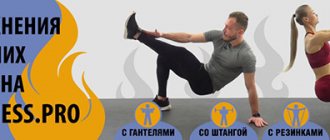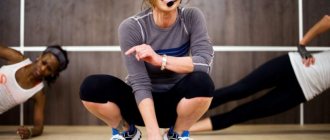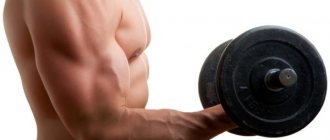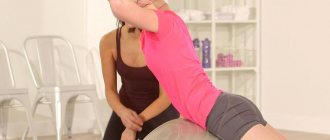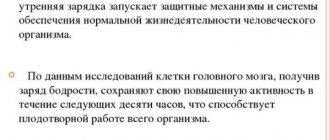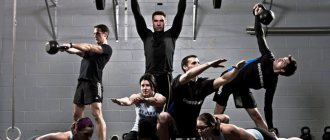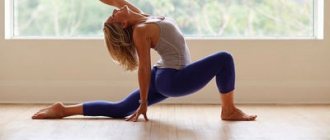Author: Tkachenko Sergey - master of sports in bodybuilding | more details >> Master of Sports of Ukraine in bodybuilding, coach. Finalist of the IFBB European Championship Moldova, Chisinau 2013. Champion of Ukraine in the category up to 70 kg. 2011. Multiple winner of the Ukrainian championships in bodybuilding and bench press. Senior moderator of our site.
Place in the author rating:
5
(become an author)
Date:
2018-10-11
Views:
15,831
Rating:
5.0
| All articles by the author >> | Medals articles >> |
Articles are loading...
What exercises are allowed for diastasis of the rectus abdominis muscles?
Due to muscle weakness, many workouts and exercises for young mothers will be prohibited. “During this period, the abdominal muscles are stretched,” says Alexandra Ryabina, a yoga teacher at the Fitness Practice - Youth club . “They are so weakened that we need to relearn how to feel them and control them.”
Therefore, all movements and workouts that involve stress on the abs are prohibited with diastasis (squats, crunches, planks, etc.). It is worth starting to work with this zone with practices that gently teach you how to work the muscles and do not overload them. Some yoga exercises and breathing practices do a great job of this.
“These include full yogic breathing, kapalabhati, agnisara dhauti kriya, cat variations,” explains Alexandra Ryabina.
Why do you need to start with breathing? “Breathing teaches us to feel ourselves, to calm ourselves, to even out the emotional background,” explains Alexandra. “When we master full yogic breathing, it teaches us how to control the abdominal muscles. A neural connection occurs in the brain.”
Experts recommend starting each session with full yogic breathing. “What are the benefits of breathing? They strengthen the inner wall of the abdomen, if we take the full yoga and kapalbhati. At the same time, they do not give a strong load, so that there is no muscle fatigue,” the expert notes.
“For diastasis, a gentle therapeutic practice is recommended, which does not include throws, planks, power twists, or lower balances,” says Alexander Gunko, teacher of hatha yoga at the Moscow School of Yoga .
“But the “cow-cat” exercises, also known as marjariasana, and half-bridge, apanasana (pulling the knees to the chest while lying on your back). Kapalbhati and uddiyana bandha will also be useful.”
Causes and symptoms
The anterior abdominal wall is formed by two large rectus muscles. Between them there is a white stripe of tendons. During pregnancy, these muscles gradually stretch, making room for the growing uterus. Being in a stretched state, the muscles become thinner and weaker. And the white stripe, consisting of weak connective tissue, expands.
The connective tissue expands most strongly in the area around the navel
Normally, 2–3 months after childbirth, the muscles become toned. Some muscle discrepancy still remains, but it is a physiological norm. But if the tissues are rather weak (this often happens after the second or third birth), they remain in a stretched state. A cosmetic defect is formed in the form of a depression in the center of the abdomen and overhanging flabby skin.
Women who have had a cesarean section experience diastasis more often than others. The abdominal muscles are injured after being cut and pulled apart, and recovery takes much longer.
To test yourself for diastasis, you need to lie on your back and place your bent legs on the floor. Raise your head and shoulders, lifting your shoulder blades off the floor. With your hand you need to feel the depression above the navel. If it exceeds 2 cm in width, we can talk about the initial stage of divergence.
To avoid severe diastasis, it is recommended to monitor your abdominal muscles long before pregnancy - they should always be in good shape. Advanced cases require surgical intervention. But discrepancies of small width can be corrected well with the help of physical exercises.
Read more about diastasis in the article - Diastasis of the abdominal muscles after childbirth is a problem that cannot be ignored.
How to do yoga correctly with diastasis
*Exclude all movements with increased stress on the abdomen and front surface of the body. “Lunges, planks, complex power asanas like chaturanga dandasana cannot be performed. With diastasis, the abdomen is weak, protruded, even from ordinary everyday movements there is strong pressure on the abdominal cavity, what to say about the positions that by default load this area?” reminds Alexandra Ryabina.
*Start classes when you feel that you have enough strength and desire. “You can start from 3-4 months after the birth of the child, but you can do it later,” says Alexandra. “Rehabilitation happens differently for everyone and you need to carefully monitor your feelings. How the body feels and what’s happening inside.”
*Don't force things. Perform as many sets and repetitions of exercises as you want and your health allows. “If you feel that that’s all for today, and you don’t want to do more activities, don’t do it. The female body is strongly connected with the planets, with the cycle, with pressure, with climate, etc. You need to adapt to your feelings,” recommends Alexandra Ryabina.
*Fix mulabandha from time to time. This is what yoga calls a “lock,” a tension in the pelvic muscles—the muscles of the perineum, vagina, and anus. “Mulabandha is a contraction of the pelvic floor muscles. They support the pelvic organs. After pregnancy, you need to rehabilitate the vaginal area and uterine area. Holding mulabandha helps to feel this area again and tone the muscles, says Alexandra Ryabina. - Pelvic floor contractions can be used throughout the day - set several timers for different times and, when they go off, squeeze and relax the muscles. And so several times.”
Training this zone improves blood circulation, which improves the health of the reproductive system. Mulabandha must be fixed in some exercises. “It must be done during breathing techniques: while inhaling, we tense the muscles, while exhaling, we relax,” explains Alexandra Ryabina. “You can alternate: five inhalations and exhalations on a tightened mulabandha and five inhalations and exhalations on a relaxed one.”
Also tense your muscles during the half-bridge hold, head-to-knee lift, and lying crunch.
We asked Alexandra Ryabina to create and demonstrate a set of yoga exercises that can be performed for diastasis.
When can you start exercising after giving birth?
Childbirth is a physical and mental stress on a woman’s body. Changes occur in almost all organs and systems:
- The uterus after childbirth is stretched and increased in volume, its weight is 1-1.5 kg. It takes at least 6 weeks for her to return to her normal size;
- internal organs, raised and compressed by the enlarged uterus, need time to return to their normal position and restore their functions;
- The hormonal background of a pregnant woman was largely determined by the activity of the placenta. After childbirth, it changes dramatically; only hormones that ensure lactation continue to be actively produced;
- During childbirth, the bones and ligaments of the pelvis move apart and become deformed, and the abdominal muscles are stretched. Natural tissue restoration after childbirth usually takes from 6 to 10 weeks;
- During pregnancy, up to 5 liters of excess fluid accumulates in the body. Its delay continues in the immediate postpartum period, which puts additional stress on the heart, swelling and, in fact, excess weight;
- During childbirth, damage to the mucous membrane of the birth canal and sometimes to the muscles of the perineum often occurs.
Therefore, on average, it takes about two months to fully restore the normal functioning of a woman’s body in the postpartum period. But everything depends on the initial state of the body and how pregnancy and childbirth proceeded.
Usually doctors allow you to exercise 5-6 weeks after giving birth, if everything went naturally and without complications. Women who have had a caesarean section or had complications during childbirth can begin physical activity no earlier than 8 weeks after the baby is born.
However, if before giving birth you did yoga, aerobics, running, Pilates, shaping or other types of fitness, if you have no complications and feel good, then you can return to training in a month. If you had no experience of physical exercise before giving birth, then you can start after about 2 months and according to all the rules for beginners.
How to build a lesson
- Start your workout with a light warm-up: rotate your head, elbows, knees, shoulders, feet.
- Do the exercises consistently. “Adjust the number of repetitions yourself, do as many as you want,” says Alexandra Ryabina.
- Take your time and work at your own pace.
- Finish the session with shavasana - lie down for 7-10 minutes with your eyes closed, consistently relaxing different areas of the body.
- Do this program daily or 4-5 times a week.
To complete the complex you will need a mat.
A set of exercises for diastasis of the rectus abdominis muscles
It consists of several breathing practices and light dynamic asanas. The key point is full yogic breathing. Start mastering it with belly breathing, then try to involve the diaphragm in this process (that's why we divided it into two different exercises).
Belly breathing
Sit comfortably with your legs crossed. You can put a pillow under the basin. Straighten your back, stretch the top of your head up. Place your palms on your knees. Take a deep breath, direct it into the stomach, expanding the abdominal cavity. As you exhale, push the air up from your lower abdomen. Breathe in this mode for 4-5 minutes or more if you want. Observe the sensations in your abdomen.
Full yogic breathing
Sit comfortably with your legs crossed. You can put a pillow under the basin. Straighten your back, stretch the top of your head up. Place your palms on your knees. Take a deep breath, trying to engage not only your stomach, but also your ribs and upper chest. Imagine that in one breath you slightly inflate your stomach, expand your chest, and direct the area under your collarbones upward. As you exhale, push the air from the lower abdomen and up. Breathe in this mode for 4-5 minutes or more if you want. Observe the sensations in your abdomen.
Kapalbhati breathing
Sit comfortably with your legs crossed. You can put a pillow under the basin. Straighten your back, stretch the top of your head up. Place your palms on your knees. Take a deep breath, then a series of short, intense exhalations. Imagine that you are pushing the air out with your abdominal wall. More details about the technology can be found here. Perform 5-10 such breathing cycles, rest for 2 minutes, then do 5-10 “repetitions” again. To begin with, you can do 30 cycles and gradually increase this number.
Kapalbhati and agnisara dhauti kriya
Sit comfortably with your legs crossed. You can put a pillow under the basin. Straighten your back, stretch the top of your head up. Place your palms on your knees. Perform two cycles of kapalabhati, then, exhaling, hold your breath, tense the muscles of the perineum and make several movements of the abdominal wall back and forth. Then take a slow, deep breath. This will amount to one repetition. Perform the practice for 10 minutes or focus on your own feelings.
Cat (classic version)
Get down on your knees, place your palms under your shoulders. As you inhale, lower your chest down, bending slightly at the lower back. As you exhale, rotate your shoulder joints back and stretch your shoulder blades upward, arching your back. This will amount to one repetition. Perform the exercise at a calm pace for 2-3 minutes.
Cat (variation)
Get down on your knees, place your palms under your shoulders. Raise your toes and shins above the floor, resting on your palms and knees. Twist your body to the left, stretching your right side as if trying to look at your left buttock. Then return to the center and repeat the same on the other side. Do the exercise at a calm pace for 2-3 minutes or more if you want.
Cat 3D
Get down on your knees, place your palms under your shoulders. Raise your toes and shins above the floor, resting on your palms and knees. Smoothly rotate your pelvis clockwise, connecting your spine and neck to this movement. Perform approximately the same number of body rotations in each direction.
Raising the head to the knee
Lie on your back, stretch your arms lengthwise to your body. Tighten your pelvic floor muscles, bend your left knee and pull it towards your stomach, smoothly lift your head above the floor and stretch your forehead towards your knee. Then relax your pelvic floor muscles and lower your leg to the floor. Repeat the same thing on the other side. Perform the same number of movements in each direction.
Half bridge
Lie on your back, stretch your arms lengthwise to your body. Tighten your pelvic floor muscles, bend your knees and gently lift your pelvis off the floor. Then lower your pelvis onto the mat and relax your pelvic floor muscles. This will amount to one repetition. Do the exercise for two to three minutes, or more if you feel like it.
